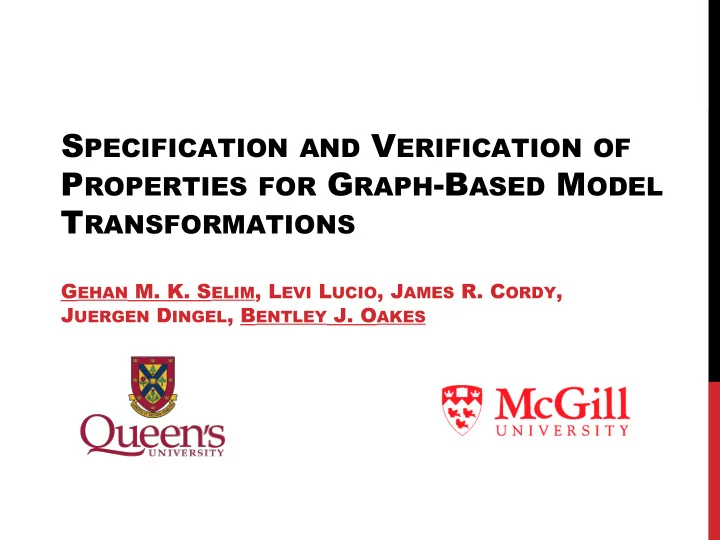

S PECIFICATION AND V ERIFICATION OF P ROPERTIES FOR G RAPH -B ASED M ODEL T RANSFORMATIONS G EHAN M. K. S ELIM , L EVI L UCIO , J AMES R. C ORDY , J UERGEN D INGEL , B ENTLEY J. O AKES
A GENDA Problem Statement DSLTrans Model Transformation Language Symbolic Model Transformation Property Prover • Overview • Phase 1: Path Condition Generation • Phase 2: Property Verification Industrial Case Study Discussion Conclusion & Future work
P ROBLEM S TATEMENT Prove pre- post- condition structural properties ● On translation model transformations ○ Example: Industrial migration transformations ● For all executions ○ No extra elements added/removed ● Infinite amount of transformation executions means the proof needs to be done on abstractions ○ Named path conditions in algorithm
D IFFERENCES FROM C URRENT T RANSFORMATION V ERIFICATION T OOLS ● Input-independent ● Little mathematical background required (v.s. Maude) ● Some scalability tests on industrial-size transformations ● Verifies multiple property types ● Proof for validity and completeness of verification technique
DSLT RANS T RANSFORMATION P ERSONS TO C OMMUNITY Restricted form of graph transformations Turing-incomplete Out-place
DSLT RANS T RANSFORMATION P ERSONS TO C OMMUNITY R ULE
S YMBOLIC M ODEL T RANSFORMATION P ROPERTY P ROVER : O VERVIEW
Phase 1- Path Condition Generation Process Layer 1 1 2 3 Process Layer 2 1 1 1 … … Process Unfeasible 1 2 Layer 3 Control Path Path 2 2 Conditions 2 2 3 3 Based on: L. Lucio, B. Barroca, V. Amaral “A Technique for the Verification of Model Transformations” Proceedings of MoDELS, 2010.
Abstraction Relation Prove properties on path condition Holds on abstracted transformation executions
Combining Path Condition with Rule Case 1: No Dependencies
Combining Path Condition with Rule Case 1: No Dependencies
Combining a Path Condition with a Rule Case 2: Rule has Dependencies and Cannot Execute
Combining a Path Condition with a Rule Case 2: Rule has Dependencies and Cannot Execute
Combining a Path Condition with a Rule Case 3: Rule has Dependencies and Will Execute
Combining a Path Condition with a Rule Case 3: Rule has Dependencies and Will Execute
Combining a Path Condition with a Rule Case 4: Rule has Dependencies and May Execute
Combining a Path Condition with a Rule Case 4: Rule has Dependencies and May Execute
Reminder: Path Condition Generation Process Layer 1 1 1 2 1 3 1 Process Layer 2 … … Process Unfeasible 1 2 2 2 Layer 3 Control Path Path Conditions 1 3 2 3 Based on: L. Lucio, B. Barroca, V. Amaral “A Technique for the Verification of Model Transformations” Proceedings of MoDELS, 2010.
P HASE 2- P ROPERTY V ERIFICATION Takes 2 inputs: 1. Path conditions generated from phase 1 2. Property to verify prop holds 1. Generated Path PC1 PC2 PCn ... prop doesn’t hold Conditions + counterexample 2. Input a) AtomicContracts: Precondition & Postcondition Property prop b) Propositional formulae of AtomicContracts (And, Or, Not, If/Then)
P HASE 2- P ROPERTY V ERIFICATION Example of AtomicContract: If a pattern of elements exists in the input Then another pattern of elements must exist in the output
Propositional Formula of AtomicContracts AtomicContracts e.g., “1..1” Multiplicity Invariants e.g.,PatternContracts If The output has a Community Verification for a pathcondition pc using Free Then {That Community will be associated Subgraph Isomorphism: Variables ! to one Man And Not More than one Man } If ( Precondition in pc & postcondition not in pc) return false Else return true A Household in the input will always be mapped to a Community in the output
I NDUSTRIAL C ASE S TUDY GM-2-AUTOSAR migration transformation [1] - GM-2-AUTOSAR Transformation Size - DSLTrans ATL 3 Layers, 2 or 3 rules per layer 2 matched rules, 9 functional helpers, 6 attribute helpers GM-2-AUTOSAR transformation Properties [2]: - Multiplicity Invariants: The transformation's output preserves - the multiplicities in the output metamodel Security Invariant: A physical node does not refer to a - software component that is not deployed on that node. - Pattern Contracts: If a pattern of elements exists in the input, then a corresponding pattern must exist in the output Uniqueness Contracts: An output element of a rule is - uniquely named if the corresponding input element is uniquely named, too. (Not handled in our prover) 1. G. Selim, S. Wang, J. R. Cordy, J. Dingel. “Model Transformations for Migrating Legacy Models: An Industrial Case Study”. ECMFA, 2012. 2. G. Selim, F. Büttner, J. R. Cordy, J. Dingel, Shige Wang.”Automated Verification of Model Transformations in the Automotve Industry”. MODELS, 2013.
I NDUSTRIAL C ASE S TUDY - Time to generate path conditions (performed once) = 0.6 secs - Time to verify properties: Multiplicity Invariants Security Pattern Invariant Contracts Property M1 M2 M3 M4 M5 M6 S1 P1 P2 Time (sec) 0.013 0.017 0.013 0.017 0.017 0.019 0.017 0.02 0.02 - Maximum time to verify a property = 0.02 sec
DISCUSSION Compared To • Result holds for any input; not limited to a scope Pros • No translation needed • Verification is much faster using our prover • Cannot prove properties that reason about attributes Cons • Cannot verify transformations with NACS Property M1 M2 M3 M4 M5 M6 S1 P1 P2 Time in our prover (sec) .013 .017 .013 .017 .017 .019 .017 .02 .02 Time in [1] within a 76 73.4 75 75 75.5 74.5 114 256 251 scope of 6 (sec) 1. G. Selim, F. Büttner, J. R. Cordy, J. Dingel, Shige Wang.”Automated Verification of Model TransfoSrmations in the Automotve Industry”. MODELS, 2013.
C ONCLUSION & F UTURE W ORK Conclusion • Extended an input-independent property prover • Property prover can verify a variety of property types • Proved soundness & completeness of property prover • Conducted a case study • Compared our prover with another verification tool Future Work • Extended scalability tests • Handle properties that reason about attributes • Verify transformations with NACs.
Recommend
More recommend